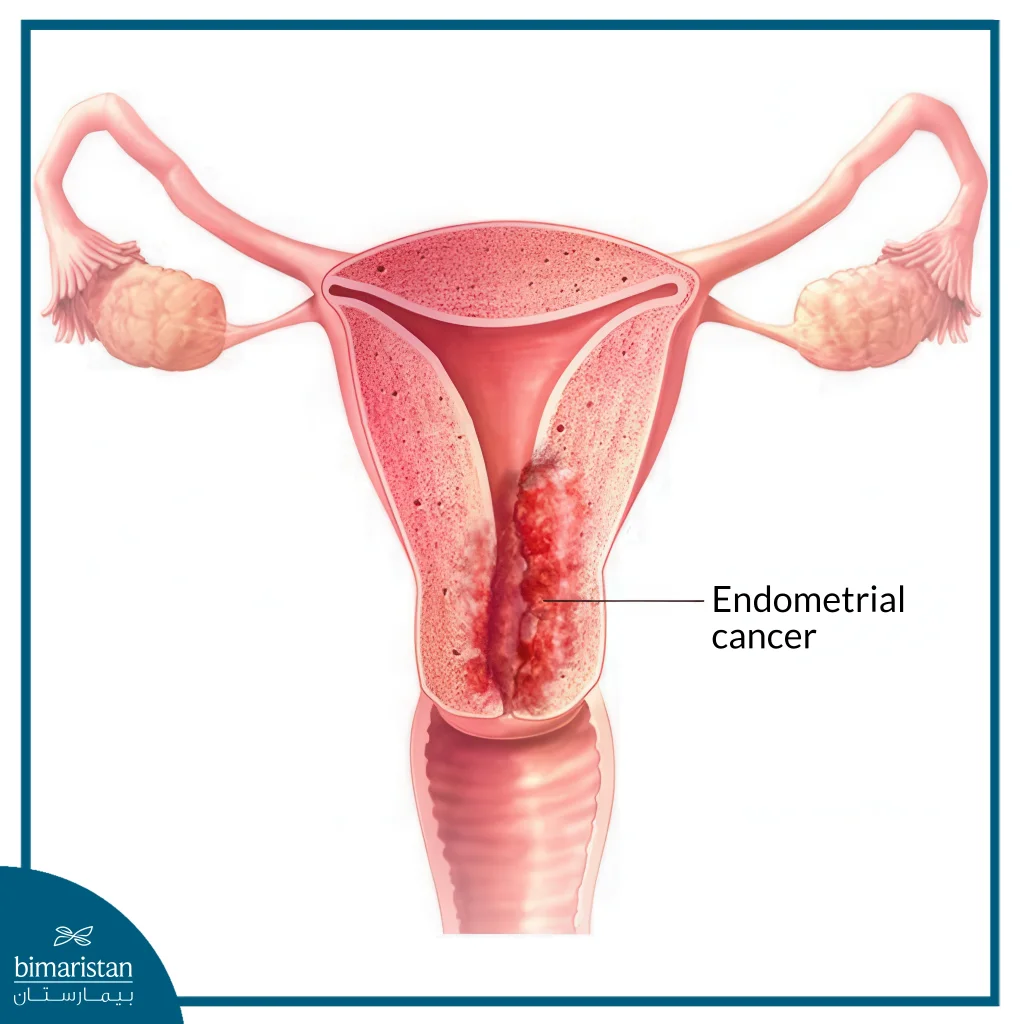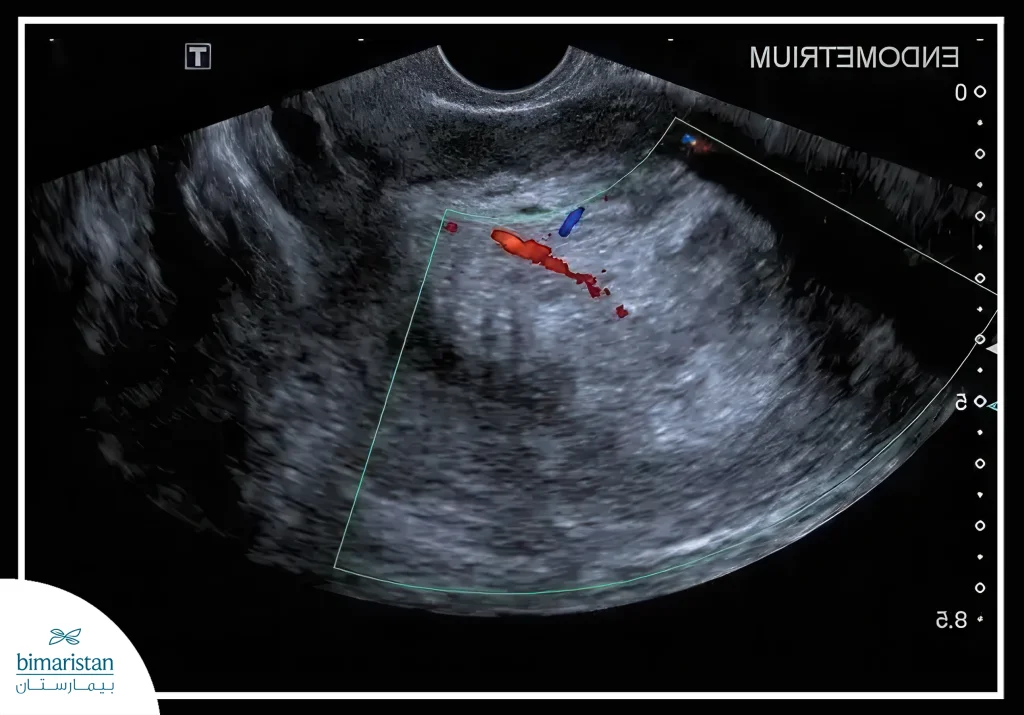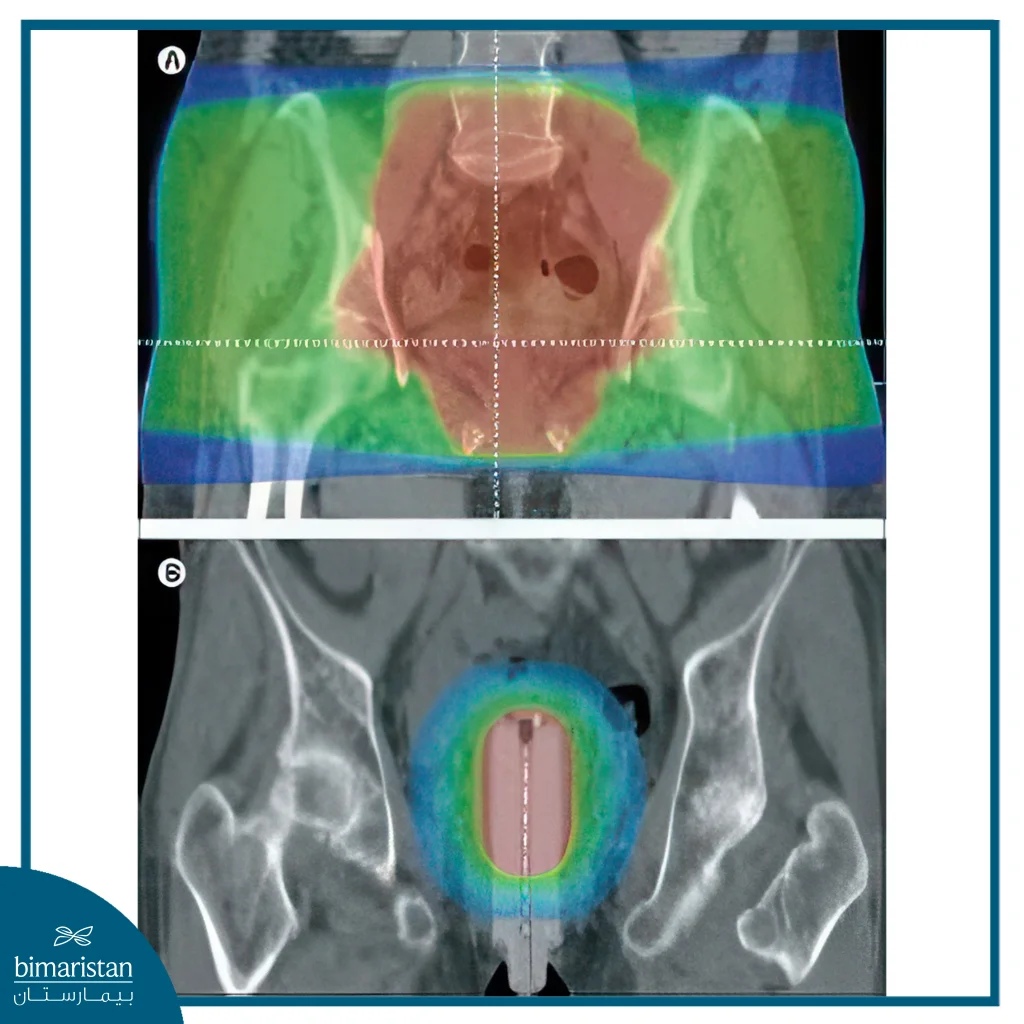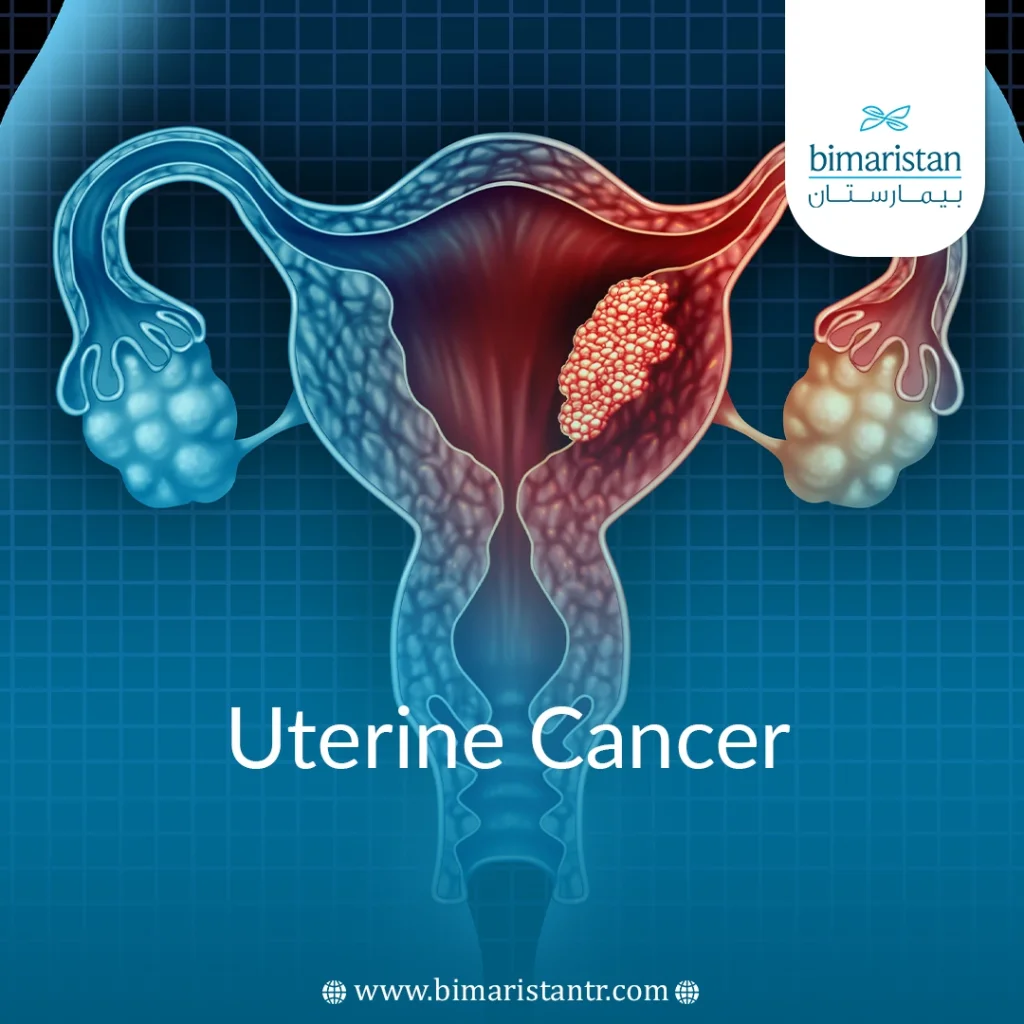Uterine cancer is one of the most common cancers in the world, accounting for approximately 3.5% of all cancers, which is why Turkey has paid great attention to the diagnosis and treatment of this disease.
Let’s first agree that there is a difference between uterine cancer (endometrial cancer or uterine sarcoma)and cervical cancers, and we will mention the difference in this article, as patients often confuse the two types.
Uterine cancer includes two types of cancer: Endometrial cancer (more common) and uterine sarcoma. Symptoms of uterine cancer include bleeding between menstrual periods or after menopause. Treatment often requires a hysterectomy to remove the tumor.
What is uterine cancer?
Uterine cancer is a general term that describes all types of uterine cancers.
The cancer often originates in the inner lining of the uterus and is one of the most common types of gynecological cancers.
There are different types of uterine cancers depending on the location or layer from which the cancer originated in the uterus, as malignant uterine sarcoma develops in the muscles of the uterine wall. Another very common type develops in the muscular layer, uterine myofibroids, in addition to other types of tumors that affect the connective tissues surrounding the uterus, but they are very rare.
The upper part of the uterus is called the body of the uterus. At the bottom is the cervical part, which connects the uterus to the vagina. The term uterine cancer refers to cancer in the body of the uterus. Cervical cancer is a separate type of cancer.
Overview of the uterus and its function
The uterus is the part of the female reproductive system that serves as an incubator for the implantation, division, and growth of the fertilized egg, forming and developing the baby until it is able to live separately from its mother.
The upper part of the uterus is called the body of the uterus, while the lower part is called the cervix, which connects the uterus to the vagina (note that the term Uterine Cancer refers to cancer of the body of the uterus, as uterine cancer is a separate type of cancer).

The endometrium is the inner layer of the uterus, which changes in thickness during the menstrual cycle.
The hormone estrogen causes the uterine lining to thicken in the case of pregnancy, if fertilization and conception do not occur, the body produces less estrogen and more progesterone, which is a different hormone in function, and when this happens, the uterine lining falls and breaks down and this is what happens in menstrual cycles.
The 28-day uterine cycle continues until pregnancy occurs, and the uterus changes and prepares itself to meet the various requirements of the fertilized egg.
Are endometrial cancers and uterine cancer the same?
Uterine cancer can refer to endometrial cancer, uterine sarcoma, or other rare forms of cancer that originate in the uterus.
Many people consider the terms “endometrial cancer” and “uterine cancer” to be the same thing, because endometrial cancers are more common than other cancers that originate in the uterus.
Uterine cancer causes and risk factors
Researchers are not sure of the exact cause of uterine cancer, but for some reason, changes occur in the cells of the uterus, and the mutant cells grow and multiply out of control, forming a mass called a tumor.
There are many risk factors for uterine cancer, many of which are related to the balance between estrogen and progesterone. Exposure to estrogen without counteracting progesterone and everything that leads to it increases the risk of developing a uterine tumor.
Risk factors for cancer include:
- Age: As women get older, the likelihood of developing uterine cancer increases. Most uterine cancers develop after the age of 50.
- Lifestyle and diet: A diet high in animal fats can increase the risk of several types of cancers, including endometrial cancer. Fatty foods are also high in calories, which can lead to obesity, as being overweight is an important risk factor for endometrial cancer.
- Family history: Some parents pass on gene mutations (changes) for hereditary nonpolyposis colorectal cancer (HNPCC), an inherited condition that increases the risk of a range of cancers, including endometrial cancer.
- Diabetes mellitus: This disease is often associated with obesity (which in turn increases the incidence of cancer), but some studies suggest a direct link between diabetes and uterine cancer.
- Obesity (excess body weight): Some hormones are converted to estrogen by fatty tissue, which increases the risk of uterine cancer. Specifically, the more fatty tissue there is, the more hormone balance changes in the body.
- Ovarian diseases: Women with certain ovarian tumors have high levels of estrogen and low levels of progesterone; these hormonal changes can cause an increased risk of uterine cancer.
- Early menstruation: If you start your period before the age of 12, you may have an increased risk of uterine cancer because the uterus is exposed to estrogen for many years.
- Late menopause: Similarly, if menopause occurs after the age of 50, the risk also increases, as the uterus is exposed to estrogen for a longer period of time.
- Long menstrual periods: The number of years of menstruation may be more important than your age when your period started or ended.
- Non-pregnancy: Non-pregnant women are at greater risk due to increased exposure to estrogen
Treatments for other conditions can also be an important cause of uterine cancer, including:
- Radiation therapy to the pelvis (between the abdomen and legs): Radiation therapy to treat other cancers can damage the DNA of cells, and this damage may increase the risk of developing a second type of cancer.
- Estrogen replacement therapy (ERT): Some people take estrogen therapy to help relieve menopausal symptoms, but women who take ERT without progesterone face a higher risk of uterine cancer.
- Tamoxifen use: People may receive this drug to treat breast cancer, it acts like estrogen in the uterus and can increase the risk of uterine cancer.
Read about: Uterine prolapse: Discover the causes, effective treatment, and prevention
What are the symptoms of uterine cancer?
Symptoms of uterine cancer may be nonspecific and similar to those of other conditions affecting the reproductive organs.
Symptoms of endometrial cancer or uterine sarcoma include:
- Vaginal bleeding between menstrual periods in premenopausal women.
- Vaginal bleeding in postmenopausal women, even a small amount.
- Lower abdominal pain or pelvic cramping just below the abdomen.
- White or clear vaginal discharge in postmenopausal women.
- Long, heavy or frequent vaginal bleeding in women older than 40
Concerned about unusual pain or bleeding? It could be uterine cancer.
At Bimaristan, we connect you with top doctors in Turkey for accurate diagnosis and advanced treatment options.
Don’t wait—early detection saves lives.
Early symptoms of uterine cancer
The symptoms of early uterine cancer are not specific enough, so the patient or her healthcare provider should pay attention to these symptoms and do the necessary investigations.
How is endometrial cancer diagnosed?
Your doctor may perform one or more tests to confirm the diagnosis of uterine cancer, including
Laboratory tests
A CA-125 assay is a blood draw in which we measure the amount of the protein marker CA-125. A certain amount of CA-125 can indicate the presence of cancer in the body (especially in the uterus, ovaries, or fallopian tubes).
Imaging tests
A CT scan takes a series of detailed images of the inside of the body.
MRI scans use radio waves and a powerful magnet to create images.
A transvaginal ultrasound inserts a special probe (a soft, rounded device) into the vagina to obtain images of the uterus.

Other tests
Surgical biopsy:
Using a thin, flexible tube through the cervix (opening of the vagina) and into the uterus, the doctor removes a portion of the tissue lining the uterus.
Hysteroscopy:
A hysteroscope, a long thin tube, is inserted through the vagina and cervix to access the uterus. This tiny instrument, equipped with a light and a camera, provides detailed images of the uterus.
Dilation and curettage (D&C):
This is a more complex procedure to remove uterine tissue, which takes place in the operating room.
Your doctor sends the sample to a lab where a pathologist examines the tissue for the presence of cancer.
How is endometrial cancer treated in Turkey?
Most people with endometrial cancer need surgery. Your management and treatment plan depend on the type of cancer and your overall health conditions. Other treatments you may receive include
- Chemotherapy: Uses powerful drugs to destroy cancer cells.
- Radiation therapy: It sends out targeted beams of radiation to destroy cancer cells.
- Hormone therapy: This involves administering hormones that inhibit cancer growth or prevent tumor-promoting hormones from taking effect.
- Immunotherapy: This treatment, in addition to targeted therapy, is a last resort when other non-surgical treatments have failed and surgery is not an option for some reason. Studies have shown that in these patients, targeted therapy has been effective in improving outcomes.
- Targeted therapy: This uses drugs to target specific cancer cells, preventing them from multiplying.

Researchers continue to study more ways to treat endometrial cancer.
What type of endometrial cancer surgery can a patient have?
Surgery is usually the main treatment for endometrial cancer. There are three types of hysterectomy procedures:
- Transabdominal total hysterectomy: The surgeon makes an incision (cut) in the abdomen to access and remove the uterus.
- Vaginal hysterectomy: The surgeon removes the uterus through the vagina.
- Radical hysterectomy: If the cancer has spread to the cervix, you may need a radical hysterectomy, in which the surgeon removes the uterus and the tissues adjacent to the uterus, the surgeon also removes the upper part of the vagina next to the cervix.
During a hysterectomy, surgeons often perform two other procedures as well:
- Bilateral salpingo-oophorectomy (BSO) removes the ovaries and fallopian tubes. Most people need this extra step to make sure all cancers are removed.
- Lymph nodes are removed and sent for pathologic dissection to see if the cancer has spread.
How is uterine sarcoma treated in Turkey?
Often, surgeons use a single procedure to diagnose, stage (characterize the severity), and treat uterine sarcoma.
Treatment options, like those for endometrial cancer, most women undergo a hysterectomy, plus BSO to remove the ovaries and fallopian tubes.
Can endometrial cancer be prevented?
Most of the time, you can’t prevent uterine cancer from occurring. But you can take steps to minimize your risk:
- Control diabetes.
- Maintain a healthy weight.
- Change your lifestyle, eat well, get enough sleep and exercise.
- Stay away from smoking.
- If you are a high-risk patient, you should see your doctor on a regular basis.
In the end, we find that endometrial cancer is one of the most common types of cancers that affect the reproductive system of women. It can be treated surgically or chemically, especially if diagnosed early. Women must take care of their health and stay away from a bad lifestyle to protect themselves and those around them.
Sources:
